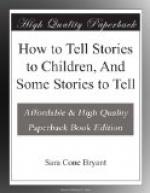CERTAIN TYPES OF STORY CLASSIFIED
FOR KINDERGARTEN AND CLASS I.:
Little Rhymed Stories
(including the best of the
nursery rhymes and the
more poetic fragments of Mother
Goose)
Stories with Rhyme in Parts
Nature Stories
(in which the element of personification
is strong)
Nonsense Tales
Wonder Tales
FOR CLASSES II. AND III.:
Nonsense Tales
Wonder Tales
Fairy and Folk Tales
Fables
Legends
Nature Stories
(especially stories of animals)
FOR CLASSES IV. AND V.:
Folk Tales
Fables
Myths and Allegories
Developed Animal Stories
Legends: Historic and Heroic
Historical Stories
Humorous Adventure Stories
“True Stories”
The wonder tales most familiar and accessible to the teacher are probably those included in the collections of Andersen and the Brothers Grimm. So constant is the demand for these that the following list may be found useful, as indicating which of the stories are more easily and effectively adapted for telling, and commonly most successful.
It must be remembered that many of these standard tales need such adapting as has been suggested, cutting them down, and ridding them of vulgar or sophisticated detail.
From the Brothers Grimm:
The Star Dollars
The Cat and the Mouse
The Nail
The Hare and the Hedgehog
Snow-White and Rose-Red
Mother Holle
Thumbling
Three Brothers
The Little Porridge Pot
Little Snow-White
The Wolf and the Seven Little Kids
The Sea Mouse
From Andersen:
Little Tiny
The Lark and the Daisy
The Ugly Duckling
The Seven Stories of the Snow Queen
The Flax
The Little Match Girl
The Fir-Tree
The Red Shoes
Ole Lukoeie
Monday
Saturday
Sunday
The Elf of the Rose
Five Peas in a Pod
The Portuguese Duck
The Little Mermaid (much shortened)
The Nightingale (shortened)
The Girl who trod on a Loaf
The Emperor’s New Clothes
Another familiar and easily attainable type of story is the classic myth, as retold in Kupfer’s Legends of Greece and Rome.[1] Of these, again, certain tales are more successfully adapted to children than others. Among the best for telling are:
Arachne
Pandora
Midas
Apollo and Daphne
Apollo and Hyacinthus
Narcissus
Latona and the Rustics
Proserpine
[Footnote 1: A well-nigh indispensable book for teachers is Guerber’s Myths of Greece and Rome, which contains in brief form a complete collection of the classic myths.]
CHAPTER III
ADAPTATION OF STORIES FOR TELLING




